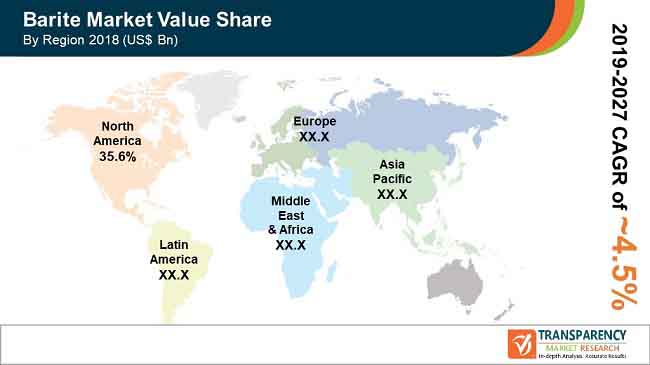
Global Barite Market: Snapshot
Barite is a mineral containing barium sulfate. The chemical formula for barite is BaSO4. It is found in various colors such as yellow, brown, white, blue, and gray. It can even be colorless. The U.S., China, India, and Morocco are the primary countries where commercial deposits of barite are found. High density and chemical inertness make barite an ideal mineral for usage in various applications. Barite is an important mineral because of its usage in exploration and development of petroleum and natural gas resources. It is mostly mined from layers of sedimentary rock. In some cases, barite is a by-product of mining lead, zinc, silver, or other metal ores.

To gauge the scope of customization in our reports Ask for a Sample
Drilling Fluids to Remain Key Application Segment in Global Barite Market
In terms of grade, the global barite market has been divided into up to 3.9, Sp. Gr. 4.0, Sp. Gr. 4.1, Sp. Gr. 4.2, and Sp. Gr. 4.3 & above. Barite is chemically inert and insoluble. Each grade is used for certain specific applications. Barite is classified based on its purity, i.e. the concentration of barium sulfate present in barite. Accordingly, the specific gravity of barite varies. Barite with specific gravity of 3.9 g/cm3 or less falls under the up to Sp. Gr. 3.9 grade segment. The Sp. Gr. 4.0 segment comprises barite with specific gravity of 4.0 g/cm3. Sp. Gr. 4.0 grade barite is usually used as a weighting agent in drilling mud applications, specifically in the oil & gas industry. Barite with specific gravity of 4.1 g/cm3 falls under the Sp. Gr. 4.1 grade segment. Barite of this grade is largely used in oil and gas drilling activities across the globe. Barite of the Sp. Gr. 4.1 grade is approved by the American Petroleum Institute (API) for usage as a weighting agent in oil and gas drilling fluids. Sp. Gr. 4.2 grade barite is a widely used barite. It has specific gravity of 4.2 g/cm3. The API has authorized its usage as weighting agent in drilling fluids. Sp. Gr. 4.2 grade barite can be used as a filler in industries such as paints & coatings, rubber, and plastics. Barite with specific gravity equal to or more than 4.3 g/cm3 falls under the Sp. Gr. 4.3 & above segment. Barite of this grade is primarily used as a filler in industries such as paints & coatings, rubber, plastics. It is also employed in pharmaceutical applications due to its high purity and low reactivity.
Get an idea about the offerings of our report from Report Brochure
Based on application, the barite market can be segmented into drilling mud, pharmaceuticals, rubber & plastics, and others. Barite is primarily employed as a weighting agent for drilling fluids in oil and gas drilling activities. Its high density, low oil absorption, low hardness, and abundance make it an ideal drilling fluid additive. Barite is widely used as filler agent in paints, coatings, and rubbers owing to its high specific density. It is employed extensively in the paints & coatings industry owing to the decrease in production of oil across the globe. Higher grades of barite are employed for medical purposes, due to their high purity, and the ability to completely absorb gamma and X-rays. Barium sulfate in suspension is regularly used medically as a radiocontrast agent for X-ray imaging and other diagnostic procedures. It is often used in imaging of the gastrointestinal tract.
More Trending Reports by Transparency Market Research – https://www.prnewswire.com/news-releases/global-chloromethane-market-to-garner-cagr-of-4-to-reach-us-3-billion-valuation-during-2019—2027-transparency-market-research-301003570.html
North America Dominated the Global Barite Market in 2018
In terms of region, the global barite market has been segregated into North America, Europe, Asia Pacific, Latin America, and Middle East & Africa. North America is the leading consumer of barite across the globe; the U.S. accounts for significant share of barite, primarily for oil and gas drilling activities. Asia Pacific follows North America. Consumption of barite in Asia Pacific is not only limited to oil and gas drilling activities, but the mineral is also used as filler material in paints, coatings, rubber, and ceramics. Consumption of barite is also high in Middle East & Africa owing to the presence of large reserves of crude oil in the region.
Increase in production of oil and gas is the key factor driving the barite market. Barite is used to elevate hydrostatic pressure to counteract high-pressure zones during drilling activities. Rise in global demand for energy has boosted the production of oil and gas. Developing nations such as China and India are expected to dominate in terms of energy consumption, largely due to the rapid industrialization and urbanization in these countries. Global production of oil and natural gas increased substantially from 2005 to 2018. This has resulted in excessive drilling and exploration activities, thereby propelling the global demand for barite. Availability of large number of substitutes for barite is likely to hamper the market. Celestite (strontium sulfate, SrSO4) and iron ore are ideal substitutes for barite. However, these alternatives are not yet widely used in the oil industry; barite continues to be the preferred commodity for usage in this application.
Looking for Regional Analysis or Competitive Landscape in Barite Market, ask for a customized report
Key Players in the Global Barite Market
The barite market is highly fragmented in China, while consolidation is evident in most regions of the world. Major producers of barite include
- Andhra Pradesh Mineral Development Corporation Limited
- Excalibar Minerals LLC
- CIMBAR Performance Minerals.
Request for covid19 Impact Analysis – https://www.transparencymarketresearch.com/sample/sample.php?flag=covid19&rep_id=2404





